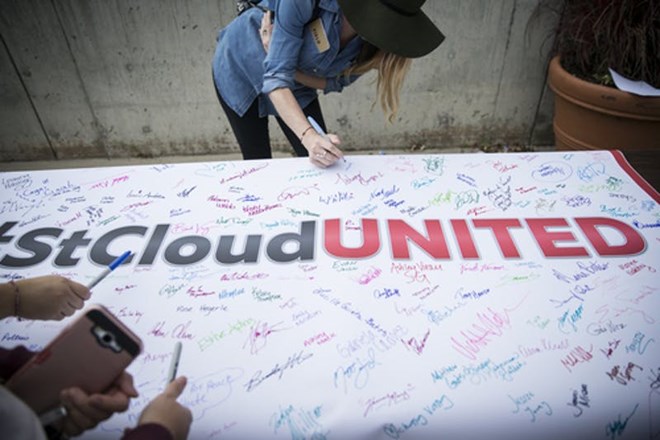
Friday June 21, 2019

There are a few ways to get your hometown splashed across the pages of the New York Times. Its Thursday morning portrait of a fearful, refugee-hating St. Cloud is probably not the most coveted one.
The piece includes a string of baffling vignettes, each one portraying white residents airing their distrust and even disgust with the couple thousand Somali refugees that have settled in town over the past decade or so.
There were accounts of people who viewed Somalis as “innately less intelligent than the ‘typical’ American citizen,” a looming menace threatening to “replace” all white people, and most sinisterly, “not from Norway.” One unnamed woman “bemoaned” sections of the city where Somali immigrants had supposedly taken over, and where white people were simply too uncomfortable to return.
“‘They were just—’ she said, searching for the words to describe the offending behavior of the Somali Americans. ‘They were just walking around.’”
Naturally, Minnesotans reacted quickly to the story on social media. Some were horrified. Some thought it was an unfair smear of a diverse, hardworking town based on the trash opinions of a vocal few—among them Mayor Dave Kleis.
"I don't think it's reflective of the community," Kleis says. He says he invited the reporter of the piece to come back to town and get a broader, more diverse read on its people, and further "balance" some of the rhetoric that appeared on the page.
But there were also a handful of readers that expressed some version of the same sentiment: Where you been, New York Times? Commenters on Twitter called the article a “hard read,” but “nothing new,” and “the most St. Cloud thing to ever St. Cloud.”
“St. Cloud making the news for (checks notes)… anti-Muslim racism,” one tweeted. “Shocker.”
This article comes three years after a City Pages piece called St. Cloud "the worst place in Minnesota to be Somali,” which included horror stories from Somali residents about being yelled at on the streets, finding pig entrails festooned across the doorways to Somali-owned shops, and kids coming home red-eyed and exhausted after a day of being bullied at school.
Later that same year, in anticipation of the 2016 presidential election, This American Life did a feature on St. Cloud on just how mainstream the belief that the town should—or even could—stop accepting Somali immigrants had become. During one fraught town hall meeting, several residents asked Republican Congressman Tom Emmer to somehow give the town “a break” from refugees. (He said he couldn’t do that.)
And that doesn’t exclude the three years since of local pieces, Reddit threads, and comment section debates all asking the same question: What’s up with St. Cloud, and why does it hate Somali people?
Natalie Ringsmuth of UniteCloud, a grassroots community-building organization featured in the New York Times article, says this piece has actually been in the works for about that long. The Times kept coming and going, pitching stories to their editors and eventually having them die for one reason or another. This one, she says, actually made it to press.
“I knew it would be scathing,” she says. She’s grateful UniteCloud was included in the conversation. Some of these stories—like the feature on This American Life—leave out the voices calling for inclusivity to further focus on those railing against it.
“We had to fight for that,” she says.
And yeah, she does understand the frustration in some of those social media comments. Not everyone in St. Cloud is like the people from those Somali-fearing vignettes. More of them, she says, are “people in the middle” who don’t know what to make of all this rancor, or what to do about it.
But the side of the city portrayed in the Times is important to talk about. The anti-Somali faction may be small, but as the Times pointed out, they got two of their favored candidates on the St. Cloud City Council last year.
“I think that for many years in this community, that sentiment has been there,” Ringsmuth says. “A Minnesota Nice version would be to not even acknowledge that those voices are out there, but the time is now to be honest about where we are.”
If anything, she wishes the Times would have dedicated more space to the people on the front lines of this issue—the Somali residents pushing back against the hate and choosing to remain right where they are, changing hearts and minds—“taking back” their narratives. Those are the people, she says, who are doing the most to make St. Cloud a better, more welcoming place.
“We move at the speed of trust, and trust is based on relationships,” she says. That may not make a very sexy story, but it is a hopeful one.